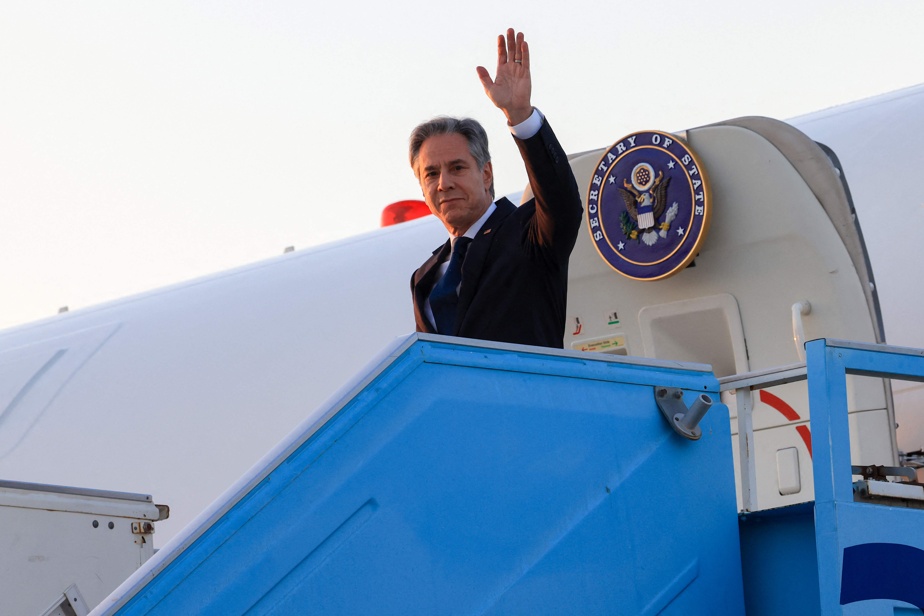(Jerusalem) US Secretary of State Antony Blinken on Monday urged Israel and the Palestinian Islamist movement Hamas “not to derail” negotiations for a ceasefire after more than ten months of war in the Gaza Strip, calling it “a decisive moment” to reach an agreement.
“This is a watershed moment, this is probably the best, maybe the last opportunity to bring the hostages home, to get a ceasefire,” Blinken said during a meeting in Tel Aviv with Israeli President Isaac Herzog.
“This is also the time to make sure that no one does anything that could derail the process,” he added. Israel and Hamas accuse each other of derailing the negotiations led by the three mediating countries – the United States, Egypt and Qatar.
Arriving in Israel on Sunday, the head of American diplomacy must also meet the Prime Minister, Benjamin Netanyahu, in Jerusalem, on the occasion of his ninth trip to the region since the start of the war in the Gaza Strip, triggered on October 7 by Israel in response to the unprecedented attack by Hamas on Israeli soil the same day.

PHOTO KEVIN MOHATT, AGENCE FRANCE-PRESSE
U.S. Secretary of State Antony Blinken met with Israeli President Isaac Herzog in Tel Aviv on August 19.
Mr. Blinken will travel to Cairo on Tuesday, where mediators are expected to resume talks this week.
“We’re working to make sure that there’s no escalation or provocation or any action that could in any way move us away from that agreement or expand the conflict to other places or increase its intensity,” Blinken continued.
Mr Herzog, whose role is mainly ceremonial, said for his part that the Israelis wanted the return “as soon as possible” of the hostages kidnapped during the attack of October 7 and held since in the Gaza Strip.
Reacting to Mr Blinken’s remarks, Israeli opposition leader Yair Lapid said it was a “call to Netanyahu: don’t miss this opportunity, you have abandoned them.” [les otages]. It is your duty to bring them back.”
Washington is hoping to end more than ten months of a devastating conflict that has tarnished the record of outgoing President Joe Biden.
For the United States, a ceasefire would also help prevent a possible attack by Iran and its allies against Israel, after their threats to retaliate for the assassination, attributed to Israel, of Hamas leader Ismail Haniyeh in Tehran on July 31, and that of the military leader of Lebanese Hezbollah, Fouad Shokr, killed the day before in an Israeli strike near Beirut.
“Always possible”
On Sunday, Mr Netanyahu called for “directing pressure on Hamas” and “not towards the Israeli government”, denouncing a “stubborn refusal” by the Palestinian movement to conclude an agreement, after two days of negotiations in Doha between the Israeli side and the American, Qatari and Egyptian mediators.

PHOTO JULIA NIKHINSON, ASSOCIATED PRESS ARCHIVES
Prime Minister Benjamin Netanyahu
“We place full responsibility on Benjamin Netanyahu for thwarting the efforts of the mediators and obstructing an agreement,” Hamas retorted.
Joe Biden, however, judged on Sunday evening that a truce in Gaza was “still possible”.
The United States, which has just approved a $20 billion arms sale to its Israeli ally, submitted a new compromise proposal during talks in Doha on Friday.
Hamas, which did not participate in the negotiations in Qatar, rejected this proposal, judging that it “responded to the conditions set by Netanyahu.”
In particular, he denounces Israel’s “insistence” on maintaining troops on the Gaza border with Egypt and “new conditions on the file” of Palestinian prisoners likely to be exchanged for hostages held in Gaza.
Hamas is demanding the implementation of the plan announced at the end of May by Mr. Biden, and is calling on mediators to “force the occupation [Israël, NDLR] to implement what has been agreed.”
The plan provides for a six-week truce in the first phase, accompanied by an Israeli withdrawal from densely populated areas of Gaza and the release of hostages abducted on October 7, and in its second phase, a total Israeli withdrawal from Gaza.
“Terrorist attack”
Mr Netanyahu has repeatedly said he wants to continue the war until the destruction of Hamas, which has been in power in Gaza since 2007 and is considered a terrorist organisation by Israel, the United States and the European Union.
Mr. Blinken’s arrival in Israel on Sunday coincided with a “terrorist attack” – claimed by Hamas and Islamic Jihad, another armed group in the Gaza Strip – which “lightly injured a passerby” in Tel Aviv, according to Israeli police.

PHOTO JACK GUEZ, AGENCE FRANCE-PRESSE
Police officers were deployed to the site of an explosion in Tel Aviv on August 18.
The Hamas attack on October 7 in southern Israel resulted in the deaths of 1,198 people on the Israeli side, mostly civilians, according to an AFP count based on official data.
Of the 251 people abducted that day, 111 are still being held in Gaza, including 39 declared dead by the army.
The Israeli offensive in the besieged Gaza Strip has left at least 40,139 dead, according to the Hamas health ministry, which does not detail the number of civilians and fighters killed.
It has caused a humanitarian disaster in the devastated Palestinian territory, which the UN says is threatened with famine. Almost all of the 2.4 million inhabitants have been displaced.
The war has exacerbated tensions on the Israeli-Lebanese border, where there are almost daily exchanges of fire between Hezbollah and Israel.
The Lebanese Health Ministry announced the death of two people on Monday in an Israeli strike in southern Lebanon, after the Lebanese Islamist movement claimed responsibility for attacks on northern Israel.
